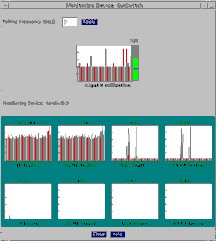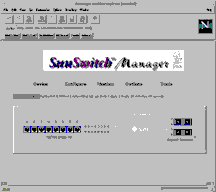Networld+Interop: Gigabit Ethernet -- Breaking the billion bit per second barrier
Ready for Gigabit Ethernet? See what we can expect from Sun, including additions to SunSwitch
|
|
Networld+Interop: Gigabit Ethernet -- Breaking the billion bit per second barrierReady for Gigabit Ethernet? See what we can expect from Sun, including additions to SunSwitch
|
|
Mail this article to a friend |
San Francisco (May 16, 1997) -- Even in the fast-paced world of networking, it hardly seems possible that the last six months would have actually seen promises and raw technology from Networld+Interop Fall 1996 turn into practical products in demonstration form. The Gigabit Ethernet Alliance has now clearly shown us that industry cooperation can speed a new technology to market. At Networld+Interop Spring 1997 in Las Vegas last week, the alliance took 28 companies with products that had not been tested for interoperability before the week prior to the show and successfully showed that the standards and technology has progressed sufficiently to prompt the industry into delivery of product.
The message was almost universal as you visited each of the vendors to see their new products. From Sun to Bay Networks, Hewlett-Packard to Cisco, Packet Engines to Rapid City Communications, everyone touted the ability to deliver tangible products starting this summer through late this year. They also emphasized that while the standards, which are about 80 percent complete today, are still awaiting ratification and completion, early products conform closely to the major standards agreed upon so far, and all these companies will migrate early adopters to the final standards-based products.
There are several standards governing Gigabit Ethernet technology. The IEEE 802.3 group is completing the 802.3z standard, which is at the core of Gigabit Ethernet. Many of the details have been worked out, including "progress on MAC (media access control) and PHY (physical) architecture, use of 8B/10B coding, basic link configuration protocol, use of CSMA/CD (carrier sense multiple access with collision detection), optical parameters for cabling and components, GMII (gigabit media independent interface), and management of Gigabit Ethernet links" according to the Gigabit Ethernet Alliance. The second draft of the standard, due to be published this month, is nearly complete.
The 802.3x flow control standard, effective in March 1997, is being used in Gigabit Ethernet for a new type of hub, known as a buffered distributor. The buffered distributor will interconnect two or more Gigabit Ethernet links, acting like an 802.3 repeater, forwarding all incoming packets to all connected links, with the ability to buffer frames to aid in flow control.
|
|
|
|
|
Envisioned applications
The key application for Gigabit Ethernet is the network backbone.
Based on this model, the switch and router products all are designed
to aggregate bandwidth from traditional 10/100-megabit network ports
onto two gigabit paths. This design places two high-capacity servers
onto a switched network, or creates a gigabit backbone to carry
traffic between multiple switches or routers, in a cascaded network
design. While Gigabit to the desktop is possible, this is not seen
as a common application of the technology -- only in circumstances
requiring large amounts of bandwidth to support imaging or
engineering analysis applications.
Since Gigabit Ethernet is based on the original Ethernet technology, it is seen as an extension to that technology. Correspondingly, the products and management techniques are based on skills already present in most organizations. Just as Fast Ethernet prevailed over 100VG because of the extension of Ethernet that Fast Ethernet represented, Gigabit Ethernet should also follow the same acceptance path. In fact, the first round of products encourages this transition, by bridging the 10/100-megabit Ethernet networks to the Gigabit networks.
What about Sun?
Just prior to Networld+Interop Spring 1997, Sun announced its first
Gigabit Ethernet solutions (See Resources.) As a steering committee
member of the Gigabit Ethernet Alliance, Sun has been at the
forefront of bringing this technology to market to solve the need
for greater bandwidth between Sun servers and the high-speed
networks that have emerged with Fast Ethernet links.
The SunSwitch is an eight-port, 10/100-megabit device with two Gigabit Ethernet ports. With the switch carrying a price of only $9,995 and each Gigabit Ethernet S-Bus NIC card at $2,295, you can connect two servers to a network of eight workstations or sub-networks at 100 megabits. Since there is such a jump in speed between the ports, it is hard to reflect on a per-port price with this technology. Instead it may be more useful for a price per 100 megabits to be considered, where the new Sun solution weighs in at a price of just $521 per 100 megabits of bandwidth offered. One other point to consider is that the server at the end of each Gigabit link has an excess of 200 megabits of network link capacity over the total of the incoming links, opening the door to at least that much bandwidth for server to server communications.
Based on the IEEE standards 802.1d for spanning tree, full and half duplex, 802.3x for flow control, and the 802.3z (draft 2) Gigabit Ethernet standard, the SunSwitch is a leading product. Judy De Puy, Sun product line manager, network products marketing, said Sun is committed to work with early adopters to migrate products to final standards-based solutions once the IEEE standards are finally approved.
At the present time, the SunSwitch requires fiber optic connections. Through 62.5 micron MM fiber, network nodes can be 300 meters apart; at 50 micron MM the fiber distance increases to 550 meters. These distances support the construction of very high-speed campus networks over existing cabling infrastructures.
One of the more exciting items demonstrated at Networld+Interop Spring 1997 was the Java interface to the SunSwitch. It is quite robust, providing a highly detailed view and configuration control of the switch to a Web browser near you. The Java control panel also exposed a future feature of the SunSwitch -- multiple cards. Presently, only a single card with the two Gigabit Ethernet ports plus eight 10/100-megabit ports is supported, but the Java interface provides for selecting cards, which De Puy confirmed would be a future enhancement to the product.
 Click image for expanded view
Click image for expanded view
|
 Click image for expanded view
Click image for expanded view
|
Is it real now?
Gigabit Ethernet is ready for early adopters. Since the standards
are not yet complete, this technology is not for organizations that
aren't ready to support changing solutions over the next year.
Standards are expected to go to vote this fall, with final approval
in the early part of 1998. But overall support by companies like
Sun, willing to come to market now to help bandwidth hungry
customers, plus the stability that the Gigabit Ethernet Alliance has
brought to the evolution of the standard has made this a fairly
safe and significant technology to adopt now.
![]()
|
|
Resources
About the author
Robert E. Lee is a technology consultant, speaker, columnist, and
author who has been in the computer industry for 20 years. He
specializes in networking, Internet strategies, systems analysis and
design activities, and has participated in the Windows NT and
Internet Information Server betas since the start of those
products.
Reach Robert at Rob.Lee@sunworld.com.
If you have technical problems with this magazine, contact webmaster@sunworld.com
URL: http://www.sunworld.com/swol-05-1997/swol-05-interop.html
Last modified: